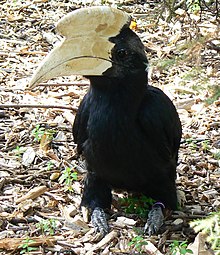Anthracoceros
| Anthracoceros | ||||||||||
|---|---|---|---|---|---|---|---|---|---|---|

A hornbill ( Anthracoceros coronatus ) |
||||||||||
| Systematics | ||||||||||
|
||||||||||
| Scientific name | ||||||||||
| Anthracoceros | ||||||||||
| Reichenbach , 1849 |


Anthracocerus , also called magpie hornbills or black hornbills , is a genus of the hornbill family(Bucerotidae). The name magpie hornbird is derived from the black and white plumage that all species have. The proportion of white is usually small. When black hornbill it limits, for example, on a broad white tip portion of the outer tail feathers, the Palawanhornvogel the body plumage is black and only the tail feathers white.
Of the five recent species, only the hornbill is considered safe. Malay hornbill and Malabar hornbill are on the IUCN advance warning level , while the palawan hornbill is considered endangered ( vulnerable ). The Suluhornbird, on the other hand, is even considered critically endangered. It originally occurred on three islands of the Philippine Sulu Archipelago and is now believed to only be found on Tawi-Tawi with around 27 sexually mature individuals.
features
The species belonging to the genus reach a body length between 50 and 70 centimeters. All have a beak with a well-formed horn or helmet-shaped attachment. This attachment ends with a pointed tip or abruptly in front of the tip of the beak.
Around the eyes and on the throat there are no feathered areas. Except for the Suluhornvogel , this featherless face is large.
The gender dimorphism is only slightly pronounced. Females are usually slightly smaller than males and, in several species, have a slightly different color pattern on the beak or the horn is slightly differently shaped. The plumage of both sexes does not differ. The color of the iris also differs in the Suluhornvogel . In the Palawan hornbill, the sexual dimorphism is particularly low: the female only differs from the male by the color of the eyes, in addition to the slightly smaller body size. The Malaysian hornbill is an exception to this principle , where the female has a noticeably different beak.
Young birds are similar to adult birds, they only have a less developed beak and beak ridge.
Distribution and way of life
Representatives of this genus occur from India to southern China and south across the Malay Peninsula to Borneo, Palawan and the Sulu Archipelago . The range of the oriental hornbird is particularly large and occurs in two subspecies from the foothills of the Indian Himalayas via Nepal and southern China to Indonesia. The palawan hornbill, on the other hand, is one of the endemics of Palawan, a Philippine island 450 kilometers and up to 40 kilometers wide, which is known for its high degree of biodiversity and endemism .
The habitat are evergreen primary forests, secondary forests, open forest areas and forest edges.
Way of life
Fruits play a major role in the diet of the anthracoceros . They cover their fluid requirements with the fruits and do not drink. They supplement this with animal protein in the form of insects and smaller vertebrates. A very wide range of vertebrates was found in the very well-studied oriental hornbill. A tame oriental hornbill has been observed to be able to catch flying swallows and bronze males . Oriental hornbills have also been observed successfully catching fish in shallow ponds. The other vertebrates that the hornbill eats include nestlings of various smaller bird species, some of which they also get from nesting holes, as well as smaller adult birds as well as bats, lizards and snakes. It also eats scorpions and snails, beetles, crickets, cockroaches, moths, butterflies, grasshoppers and termites.
The representatives of the genus Anthracoceros are cave breeders , whereby the female from the inside and the male from the outside wall up the niche cave entrance immediately after laying the eggs with clay, earth and their own droppings. Only a small slit remains through which the male and the male can provide food. The clutch comprises between one and four eggs, which are laid at least two days apart. The incubation period is 25 to 30 days, the nestling period is between 49 and 63 days.
The female moults in the brood cavity.
species
- Hornbill ( Anthracoceros coronatus )
- Malay Hornbill ( Anthracoceros malayanus )
- Palawan hornbill ( Anthracoceros marchei )
- Oriental hornbill ( Anthracoceros albirostris )
- Suluhornvogel ( Anthracoceros montani )
- Anthracoceros convexus
- Anthracoceros malabaricus
literature
- W. Grummt , H. Strehlow (Ed.): Zoo animal keeping birds. Verlag Harri Deutsch, Frankfurt am Main 2009, ISBN 978-3-8171-1636-2 .
- Alan Kemp: The Hornbills - Bucerotiformes . Oxford University Press, Oxford 1995, ISBN 0-19-857729-X .
Web links
Single receipts
- ↑ a b Kemp: The Hornbills - Bucerotiformes . P. 170.
- ↑ Anthracoceros albirostris in the endangered Red List species the IUCN 2012. Posted by: BirdLife International, 2012. Accessed October 23, 2016th
- ↑ Anthracoceros coronatus in the endangered Red List species the IUCN 2012. Posted by: BirdLife International, 2012. Accessed October 23, 2016th
- ↑ Anthracoceros marchei in the endangered Red List species the IUCN 2012. Posted by: BirdLife International, 2012. Accessed October 29, 2016th
- ↑ Anthracoceros montani in the endangered Red List species the IUCN 2013. Posted by: BirdLife International, 2013. Accessed October 29, 2016th
- ↑ a b Kemp: The Hornbills - Bucerotiformes . P. 159.
- ↑ W. Grummt, H. Strehlow (Ed.): Zoo animal keeping birds . P. 541.
- ↑ Kemp: The Hornbills - Bucerotiformes . P. 168.
- ↑ Kemp: The Hornbills - Bucerotiformes . P. 167.
- ↑ W. Grummt, H. Strehlow (Ed.): Zoo animal keeping birds . P. 541.
